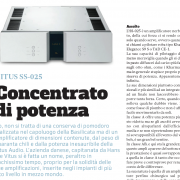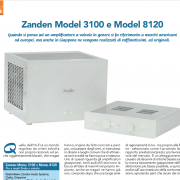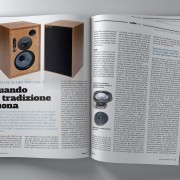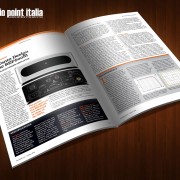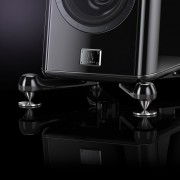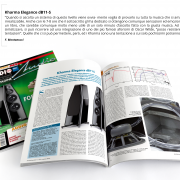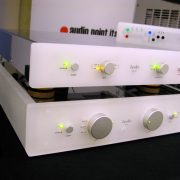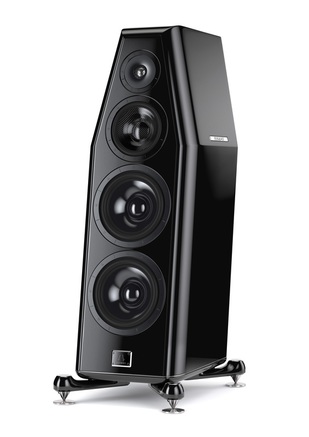
E’ sempre più difficile districarsi in un mercato che sembra ogni giorno di più un giungla. Ci si deve muovere in una moltitudine di proposte tra le più eterogenee.Se la meta comune (o presunta tale) è quella della corretta riproduzione del suono, d’altra parte riscontriamo che i metodi e le tecnologie impiegate per raggiungerla, sono i più diversi, soprattutto per quanto riguarda i diffusori.
Radiazione diretta, trombe, dipoli, elettrostatici, ibridi, dai monovia ai 4 e più vie e chi più ne ha, più ne metta.
E a tutti potremmo attribuire una parte di ragione. Chiunque affermi che esiste una tecnologia sempre e comunque superiore, ha torto, a parere di chi vi scrive.Ci sono implementazioni di ognuno di questi sistemi che possono essere tranquillamente definite buone, come anche meno buone, a seconda di chi le ha progettate o realizzate. E, a pari qualità, dobbiamo pensare alle diverse esigenze dei fruitori; non si può pensare di piazzare un sistema a tromba in 10 mq, ad esempio.
Ecco perchè noi di Audio-activity.com spaziamo volentieri tra le varie tecnologie, senza pregiudizi di alcun genere, che comprometterebbero la nostra serenità di giudizio. La nostra politica è quella di ascoltare, e di raccontarvi come suona il prodotto di volta in volta in prova.
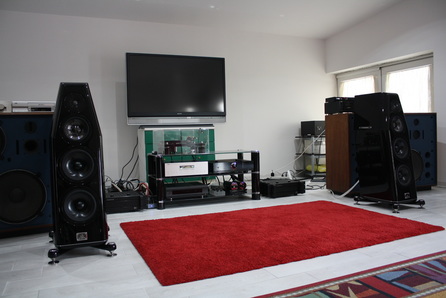
Oggi tocca a Kharma, un marchio non certo tra i più vecchi del mercato dell’audio, ma che ha saputo posizionarsi, in pochi anni, ai vertici mondiali della qualità.
Non amiamo le classifiche, in linea di principio, ma negare che Kharma sia tra i primi 10 marchi al mondo per qualità percepita dagli appassionati audio, sarebbe un errore.Seguo Kharma da un bel po’ di anni, quando il precedente distributore italiano, in Torino, le dimostrava nel suo negozio. Ricordo perfettamente che in quel frangente, erano amplificate da un finale DarTZeel, il 108. Si poteva ascoltare un suono che ricordo ancora con piacere, sempre che non si esagerasse con la richiesta di potenza, che in quel caso il finale andava in clipping ed accendeva i suoi occhioni color arancio, per avvisare che non ne aveva più. Quale fosse il modello di Kharma non saprei dire, so per certo che si trattava della serie Ceramique. Dopo qualche anno ho avuto occasione di recensire le Kharma 3.2.2 per AUDIOReview, con un risultato che definirei lusinghiero, ma senza promuoverle a pieni voti, non essendo del tutto convinto dal loro suono.
Col passare degli anni, Charles van Oosterum, fondatore e progettista di Kharma, ha maturato la decisione di stravolgere i progetti di tutti i modelli in produzione, abbandonando gli altoparlanti ceramici, in favore di altre tecnologie e lavorando sui cabinet e sui crossover.
Qualche mese fa, in occasione della mostra di Lanciano, ci siamo fatti raccontare dallo stesso Charles le motivazioni di tali cambiamenti e le abbiamo riportate in quest’intervista:
www.audio-activity.com/cvo-intervista.html
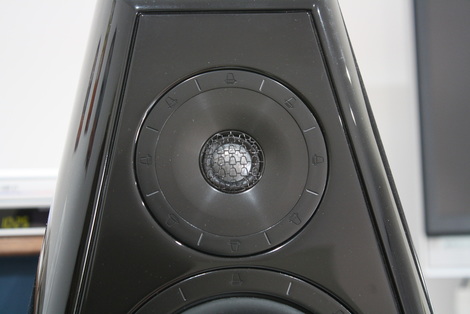
Quindi, come dicevamo, le nuove serie sono realizzate con altoparlanti prodotti con materiali diversi: i woofer sono in alluminio, i midrange in un materiale composito sviluppato dalla stessa Kharma e chiamato Omega 7, mentre la cupola dei tweeter è di pregiato Berillio, un materiale molto in voga ultimamente, che coniuga una durezza quasi pari a quella del diamante, con un costo che, sebbene molto elevato, resta ancora accessibile.
Tra le caratteristiche tecnico/estetiche adottate da questa nuova serie di Kharma, troviamo le eleganti griglie, a fissaggio magnetico, invisibile. E a proposito di invisibilità, avrete fatto caso a come le viti che fissano gli altoparlanti al pannello frontale, siano nascoste alla vita tramite anelli recanti il marchio della Casa, dello stesso colore del pannello. Il risultato globale è di una pulizia di linee rara a riscontrasi sul mercato.La forma del mobile è quella classica per Kharma, tendente a ridurre la larghezza del baffle nella parte superiore del mobile, dove si trovano gli altoparlanti di dimensioni inferiori e più sensibili alle riflessioni causate dal mobile. La stabilità è assicurata da 4 massicci supporti neri che sporgono dagli angoli del cabinet, ai quali si dovranno assicurare le quattro grosse punte fornite in dotazione e complete di sottopunta. La parte posteriore ospita il foro del condotto reflex, di ridotte dimensioni, ed i pratici morsetti Cardas che hanno il solo difetto di non accettare terminazioni a banana.Queste le caratteristiche dichiarate:
System: 3-way
RMS Power: 250 Watt
Program power: 500 Watt
Frequency range: 26 Hz – 30 kHz
Nominal Impedence: 4 Ohm
Efficience 2,83V / 1m: 89 dB
Maximum SPL: 113 dB
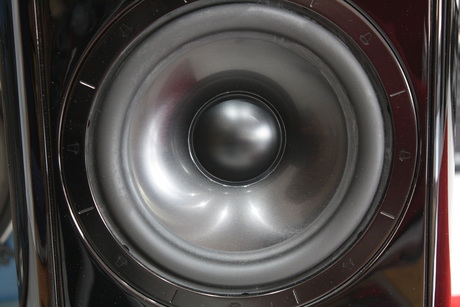
Parliamo adesso del loro suono.
Le Kharma Elegance dB9-S sono state connesse al seguente sistema:
giradischi Basis 2001, braccio Graham 2.2, testina Lyra Kleos, pre phono: Einstein “The Turntable’s Choice” bilanciato, lettore CD/SACD Yamaha CD-S3000, lettore multimediale: Oppo 105 D, preamplificatore: MBL 4006, finali: Bryston 7B ST, diffusori: JBL 4350B, cavi di segnale: MIT Oracle MA-X Proline, MIT Shotgun S2 RCA, Transparent Super XLR, Transparent Super RCA, cavo phono Cammino PH B 2.2 Ref XLR, cavi di potenza: MIT Magnum MA, Vovox Initio, cavo USB MIT SL-Matrix USB, cavi di alimentazione: MIT Shotgun AC 1, Black Noise Pearl ed altri auto-costruiti, distributore di rete: Lector Edison 230/8, filtro di rete: Black Noise 2500.Non possiamo negare che ci si accinge all’ascolto di apparecchi di questo livello con un po’ di timore reverenziale. Una cosa è entrare nella saletta di uno show audio per un fugace ascolto, altra è sballarli in casa propria, posizionarli, cercare di comprenderne ogni sfumatura, far passare decine di dischi, per poi raccontare ciò che si è ascoltato a chi ha la bontà di leggerci.Questa volta si comincia con “Le Sacre du Printemps”, un SACD DG eseguito dalla Los Angeles Philharmonic Orchestra diretta da Salonen.
Il primo brano del SACD è in effetti La Notte sul Monte Calvo di Mussorgsky. Si tratta di un brano molto dinamico, a tratti violento, intonato al resto del programma: Il Mandarino Miracoloso di Bartók e, appunto, la Sagra di Stravinsky. Si richiede, per l’esecuzione di queste partiture, un’orchestra diretta con polso e precisione. Esa-Pekka Salonen, finlandese, attuale direttore della Philharmonia Orchestra di Londra, dimostra abilità e sicurezza nella conduzione della compagine californiana. La registrazione è all’altezza della produzione, con una ripresa del suono molto vicina all’ideale.Gli strumenti sono ben piazzati sul palcoscenico virtuale, la dinamica dei Fortissimo e delle percussioni è notevole e, malgrado ciò, gli strumenti non sono mai congestionati e restano perfettamente intelligibili. I violenti colpi delle percussioni, a partire dalla grancassa, presenti un po’ ovunque nelle tre diverse composizioni, non scompongono mai le Kharma, che reagiscono con una forza inaspettata, senza mai perdere il controllo. Quando il percussionista stoppa con la mano la pelle della grancassa, riducendola al silenzio, i woofer sembrano essere un tutt’uno con la membrana del grosso tamburo. Prestazione notevole, soprattutto perché si tratta di coni dal diametro tutto sommato ridotto. Sofismi da recensore a parte, le dB9-S sono letteralmente sparite, non si percepisce la loro presenza e la mente è libera di tornare ad un anno fa, quando ho assistito dal vivo alla Sagra diretta sempre da Salonen, alla testa dell’Orchestra Filarmonica della Scala di Milano.
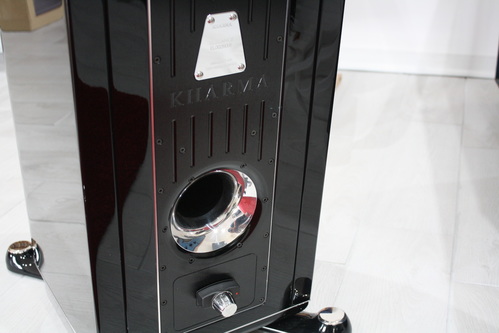
Non molte registrazioni, sebbene anche qui vi siano mille imperfezioni, rendono il senso della naturalezza come “Time Out” del Dave Brubeck Quintet, soprattutto nella curata rimasterizzazione del SACD Columbia/Legacy.
Il volume sembra non bastare mai, basso e batteria sono posizionati dietro al sax ma in misura minore di quanto accade di solito, giustamente. La ripresa è stata fatta in uno studio, non in un teatro e gli strumenti non potevano essere troppo distanti l’uno dall’altro.
Con le Kharma, ce ne accorgiamo, dunque. Il contrabbasso è preciso nel suo incessante lavoro, mentre le spazzole del magnifico Joe Morello accarezzano la pelle del rullante, tra un accento e l’altro. Il suono del pianoforte sembra meglio del solito, in un contesto di estremo equilibrio tonale, nel quale anche il sax di Paul Desmond si integra alla perfezione.
Ottimi anche i piatti della batteria, grazie al perfetto intervento dei pregiati tweeter in berillio. Questi ultimi, infatti, suonano materici e, allo stesso tempo, ricchi delle armoniche necessarie per riprodurre suoni simili a quelli d’origine.Se mi seguite regolarmente, sapete già che mi piace testare la versatilità dei diffusori, utilizzando tutti i generi musicali. Sul piatto c’è ora un vinile di un gruppo “Hard Rock” (allora si chiamava così) degli anni 70: Uriah Heep. Il disco si intitola Very ‘eavy … Very ‘umble (Bronze Records).
Le finora compassate Kharma si trasformano improvvisamente in “Gods of Metal”, sfoderando una grinta insospettabile. Organo Hammond, chitarre distorte, la voce graffiante di David Byron; non manca nulla ed il coinvolgimento è totale. Un bel salto nella prima metà degli anni ‘70. Il suono mi riporta alle sale prova di quando anch’io suonavo in band di Rock. Incisione abbastanza curata, in rapporto ai lavori dell’epoca, e riproduzione ottima. Ne approfitto per segnalarvi, proprio in questo disco, un’emozionante versione della famosa “Come Away Melinda”, plurieseguita da molti artisti, negli anni.Nessuna difficoltà da parte dei potenti Bryston per ottenere un volume di fuoco credibile anche per questo genere musicale, né da parte delle dB9-S che, se amplificate a sufficienza, suonano fortissimo senza scomporsi.Ascoltando la 3° di Beethoven “Eroica” (LP Westminster) eseguita dalla Vienna State Orchestra diretta da Hermann Scherchen, subito si notano l’ampiezza della ricostruzione dell’orchestra, la vivace dinamica e la capacità di emissione senza particolare sforzo delle Kharma. Il tutto contribuisce a fornire un risultato globale entusiasmante.
I tweeter, sempre sotto ferreo controllo, rifiniscono alla perfezione l’aria tra gli strumenti ed il soundstage.Cosa c’è di più indicato per rilassarsi, dopo una convulsa giornata di lavoro, del “The Cannonball Adderley Quintet in San Francisco”? (SACD Riverside). Pochi canonici minuti per portare in temperatura gli altoparlanti e le elettroniche, ed il volume sale a livello quasi live. La registrazione è del 1959, gli strumenti sono stati “panpottati” nei due canali, lasciando ben poco tra i due diffusori. Eppure le 2 Kharma colgono così bene l’essenza della musica, che si passa sopra a tutto e si bada solo a tenere il tempo coi piedi e la testa, mentre ci si gode la stupenda musica ed i grandi musicisti che la suonano.
Parlare del suono dei singoli driver rischia di far torto alle prestazioni del crossover o al sordo (alle risonanze) cabinet che li contiene, ma nessuno se ne avrà a male se dico che i tweeter in berillio sono stratosferici ed i midrange non sono da meno: precisi e veloci, senza quelle sporadiche asprezze o colorazioni – spesso anche piacevoli – dei predecessori ceramici.
La gamma media riesce così ad avere un’impronta dolce ma senza colorazioni udibili.
In più, le dB9-S riescono a suonare molto forte senza palesare distorsioni fastidiose, anche grazie ai due piccoli ma possenti woofer.
A testimonianza di ciò, la batteria di Jack DeJohnette in “Inside Out” (CD ECM) è credibile, veloce e dinamica, come si addice ad una batteria ben registrata.
In conclusione, abbiamo appena provato una coppia di diffusori dal suono di altissimo livello, finite lussuosamente e ben disegnate, tanto da poter essere felicemente ambientate in qualsiasi abitazione e con qualsiasi arredamento.
Non ci sono dubbi: Kharma si è guadagnata con pieno merito di stare in compagnia coi principali produttori mondiali di diffusori, già con questa serie Elegance, che in fondo non è che la serie d’ingresso della produzione dell’azienda olandese. Oltre, abbiamo le serie Exquisite ed Enigma Veyron, che giocano in altri campionati.
Segnaliamo anche che le dB9 (non S), esistono anche in versione attiva.
Il prezzo è su un livello già troppo elevato per poter parlare di rapporto qualità/prezzo, quindi lascio volentieri che ognuno giudichi in coscienza, possibilmente dopo averne valutato l’altissima qualità realizzativa ed il suono.
Ascoltatele in un impianto ben allestito e, possibilmente, in ambiente curato; non ve ne pentirete.
Angelo Jasparro
Produttore: Kharma
Distributore per l’Italia: Audio Point Italia
Prezzo listino: 31.800 euro
http://www.audio-activity.com/kharma-elegance-db9-s.html


